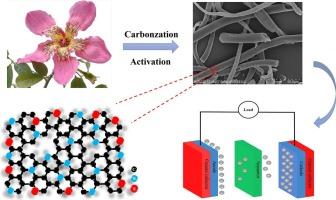Preparation of nitrogen and sulfur co-doped tubular porous carbon derived from Ceiba speciosa flowers for supercapacitors
IF 8.9
2区 工程技术
Q1 ENERGY & FUELS
引用次数: 0
Abstract
The utilization of biomass for producing porous carbon presents significant promise for supercapacitor electrode materials. This work introduces an efficient and environmentally friendly two-step synthesis method for preparing Ceiba speciosa flowers derived porous carbon (CSDC). The findings highlight the tubular porous character of the resulting carbon material. Notably, the sample (CS-700-T2) using thiosemicarbazide as a dopant results in a pore volume of 0.949 cm3·g−1 and an exceptionally high SSA of up to 2090 m2·g−1. CS-700-T2 exhibits outstanding electrochemical performance, achieving a capacitance of 355.3 F·g−1 at 0.5 A·g−1. Its exceptional rate capability is evidenced by maintaining 83.1 % capacitance at 20 A·g−1. In a symmetric CS-700-T2||CS-700-T2 electrode system, the capacitance remains at 97.3 % after 10,000 cycles at 5 A·g−1. Furthermore, to enhance the energy density, Na2SO4 was used as the electrolyte, successfully expanding the operating voltage to 0–1.6 V. This adjustment significantly increases energy density, reaching 26.2 Wh·kg−1. Therefore, the synthesized CS-700-T2 material, with its exceptional electrochemical performance, stands out as a powerful contender for future SC electrode materials.

超级电容器用木棉花氮硫共掺杂管状多孔碳的制备
利用生物质生产多孔碳为超级电容器电极材料提供了重要的前景。介绍了一种高效、环保的两步法制备Ceiba speciosa花衍生多孔碳(CSDC)的方法。这些发现突出了所得到的碳材料的管状多孔特性。值得注意的是,使用硫代氨基脲作为掺杂剂的样品(CS-700-T2)的孔体积为0.949 cm3·g−1,SSA高达2090 m2·g−1。CS-700-T2表现出优异的电化学性能,在0.5 a·g−1时电容达到355.3 F·g−1。在20 A·g−1时保持83.1%的电容,证明了其卓越的速率能力。在对称的CS-700-T2||CS-700-T2电极体系中,在5 a·g−1下循环10,000次后,电容保持在97.3%。此外,为了提高能量密度,使用Na2SO4作为电解液,成功地将工作电压扩展到0-1.6 V。这一调整显著提高了能量密度,达到26.2 Wh·kg−1。因此,合成的CS-700-T2材料以其优异的电化学性能,成为未来SC电极材料的有力竞争者。
本文章由计算机程序翻译,如有差异,请以英文原文为准。
求助全文
约1分钟内获得全文
求助全文
来源期刊

Journal of energy storage
Energy-Renewable Energy, Sustainability and the Environment
CiteScore
11.80
自引率
24.50%
发文量
2262
审稿时长
69 days
期刊介绍:
Journal of energy storage focusses on all aspects of energy storage, in particular systems integration, electric grid integration, modelling and analysis, novel energy storage technologies, sizing and management strategies, business models for operation of storage systems and energy storage developments worldwide.
文献相关原料
公司名称
产品信息
麦克林
Hydrochloric acid
麦克林
Potassium carbonate
麦克林
Ethanol
阿拉丁
Polytetrafluoroethylene emulsion
阿拉丁
Potassium hydroxide
 求助内容:
求助内容: 应助结果提醒方式:
应助结果提醒方式:


